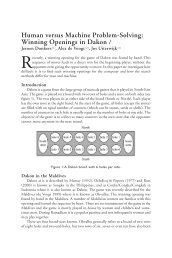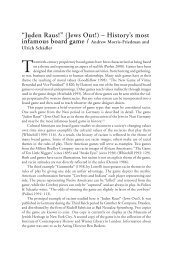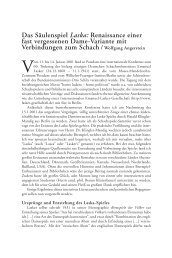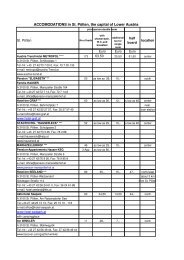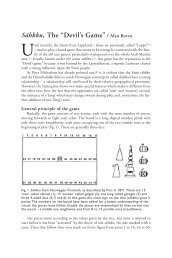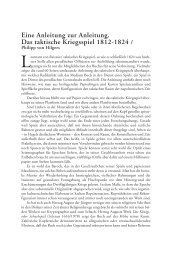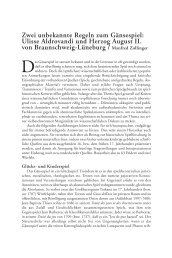A Patolli Game In Maya Lowland - Board Game Studies
A Patolli Game In Maya Lowland - Board Game Studies
A Patolli Game In Maya Lowland - Board Game Studies
Create successful ePaper yourself
Turn your PDF publications into a flip-book with our unique Google optimized e-Paper software.
Bul: A <strong>Patolli</strong> <strong>Game</strong> in <strong>Maya</strong> <strong>Lowland</strong> / Lieve Verbeeck<br />
comparative ethnographic research on colonial and contemporary Mesoamerican<br />
(1) board games revealed that the <strong>Maya</strong> board game, called bul, played by the<br />
Mopan and K’ekchi’ farmers in Southern Belize (2) , is a native American game.<br />
There is a well-marked affinity and relation between the pre-Conquest “game of the mat<br />
and patol beans” of the Aztec, called patolli, and its various twentieth century manifestations.<br />
1. <strong>In</strong>troduction<br />
<strong>In</strong> the pre-Conquest times games of chance employing beans or reeds as dice were quite<br />
popular and widespread in Mesoamerica. Although there is an abundance of ethnohistorical<br />
documents, no accurate description has been found of how these games were<br />
played. Even the well-known Aztec board game of patolli is still a riddle. Only the<br />
“superstitious” aspects of the game and the heavy betting that went with it are well<br />
documented. If we are to believe what the earliest Spanish chroniclers wrote about the<br />
native American games of chance, we must assume that by the end of the sixteenth century<br />
the Mesoamerican games were abolished (fig. 1) and replaced by Spanish or Old World<br />
games (Duran 1967, Sahagún 1981). Besides, the twentieth century ethnographers and<br />
anthropologists do not show much interest in the games of the native Americans either.<br />
The reason probably is that there is no direct demonstrable association between modern<br />
recreational games and divination. No doubt, in ancient times the Mesoamerican games<br />
must have had a mantic significance, but at the eve of the Conquest sheer gambling was<br />
the main objective of the native American gamesters. On the other hand ethno-historians<br />
and archaeologists are still studying the various designs of the patolli boards that have been<br />
discovered in ancient sites all over the Mesoamerican area. Although there are still many<br />
questions unanswered, it is generally accepted that the patolli boards are cosmological<br />
images (Caso 1924-27, Duverger 1978, Swezey and Bittmann 1983).<br />
By now the term patolli has become a generic term. It does no longer signify one<br />
specific Aztec game of chance, played on a mat on which there was drawn a cruciform<br />
board, with four black, marked patolli beans as dice (fig. 2). <strong>Patolli</strong> now labels any<br />
variant of the square, cruciform or circular game-boards drawn or incised on floors or<br />
benches of ancient Mesoamerican buildings (figs. 3 to 6), or featuring in the multiple<br />
pre-colonial or early-colonial codices (figs. 7 to 9), as well as some of the twentieth<br />
century games of chance that are assumed to be survivals or variants of the ancient game<br />
of patolli. For indeed, in some remote areas, safely away from the surveilling and<br />
punishing Spanish authorities, indigenous groups preserved their ancestors’ games of<br />
chance well into the present century.<br />
Nevertheless, it must be considered a lucky coincidence that this author recently had<br />
the opportunity to observe a <strong>Maya</strong> board game in the field (3) . <strong>In</strong> the tide of modern<br />
civilization and technology even the most isolated communities are swiftly substituting<br />
their cultural heritage for the “blessings” of westernized societies. And thus, the
L IEVE V ERBEECK / BUL: A PATOLLI G AME IN M AYA LOWLAND<br />
Fig. 1: Execution of a patolli player. His patolli board, dice, counters and bundle with<br />
supersticious objects are being burnt (Relaciones Geográficas: Tlaxcala, Tomo<br />
I. 241v 11).<br />
83
84<br />
Fig. 4:<br />
Xunantunich,<br />
Belize,<br />
patolli Type I<br />
(after Mackie,<br />
1961)<br />
Fig. 6: Chichen<br />
Itzá, Mexico,<br />
patolli (after<br />
Ruppert, 1943,<br />
fig. 4c)<br />
B OARD G AMES S TUDIES 1, 1998<br />
Fig. 2: <strong>Patolli</strong>, codex<br />
Florentino, lam.<br />
XLVIII, nr. 63,<br />
reproduction from<br />
the work of<br />
Sahagun, Madrid,<br />
1905<br />
Fig: 7: <strong>Patolli</strong> in Codex<br />
Borbonicus,<br />
p. 19, facsimile edition,<br />
commentary by Hamy, Paris,<br />
1899.<br />
Fig. 3: <strong>Patolli</strong>,<br />
El Tajín, Mexico<br />
(after Duverger,<br />
1978, fig. 4c)<br />
Fig. 5.<br />
Teotihuacán,<br />
Mexico, patolli<br />
Type II (after<br />
Bernal, 1963,<br />
lam. 9:3)
L IEVE V ERBEECK / BUL: A PATOLLI G AME IN M AYA LOWLAND<br />
traditional games are being dismissed by the younger generations. The registration of the<br />
ancient games is becoming an urgent issue, not only for native American folklorists and<br />
ethno-historians but also for the indigenous groups themselves, if they are really<br />
concerned about safeguarding various aspects of their cultural heritage.<br />
The study of Mesoamerican board games comprises a large and still unexplored field.<br />
<strong>In</strong> the scarce literature on contemporary Mesoamerican board games most descriptions<br />
date from the first half of the twentieth century. The ethnographers seldom gave an<br />
accurate reflection of the rules or the playing context and often did not bother to make<br />
a distinction between Old World and New World games. Ventur’s structural description<br />
of the Mopan dice games stands in contrast to the vague accounts in most colonial and<br />
even modern sources (Ventur 1980: 257). The purpose of this paper is twofold: first, to<br />
present the Belizean version of the game of bul, as it was observed in its natural context<br />
by this author, and second, to prove that the board game bul indeed is a modern variant<br />
of the ancient Mesoamerican patolli game. For that purpose the data on bul will be<br />
compared with what is known about a few other Mexican board games. At the same time<br />
this comparison should result in a tentative typology of the patolli games.<br />
2. Bul, a Ceremonial <strong>Game</strong><br />
One day in the month of May, my Mopan hosts invited me to the customary vigil<br />
ceremonies they perform before planting their corn. For that purpose the helpers at the<br />
next day’s planting use to come to the hut of the farmer to spend the night with him.<br />
After the habitual prayers and incense-offerings to the God of the Earth and the Wood,<br />
Santo Witz, Santo Hook, Santo Che’, in front of the house altar, the men told me that<br />
now I was going to witness an important part of the ceremony: they were going to “play<br />
corn”. One Mopan man took some grains of corn out of one of the corn bags in the hut<br />
and put them on the floor in a straight line. <strong>In</strong> the meantime the others went outside to<br />
look for suitable counters, each of them returning with five similar small pieces of twig,<br />
leaf stem or grass, different from the counters of the other players. They formed two<br />
teams and squatted on the floor, in front of each other with the corn “track” between<br />
them. One player then looked for four suitable grains of corn to make the lots, the corn<br />
dice. One side of each grain was blackened with charcoal he took from the cooking fire.<br />
And then the game could be started. It appeared to be a kind of a war-game. The players<br />
moved their men up and down along the corn-track by throws of the four corn-dice,<br />
called bul, which is also the name of the game. During a break the players drank large<br />
cups of their traditional cocoa. At a certain moment the farmer took the incense burner,<br />
lighted its fire and went outside the hut to pray again to the God of the Wood. I learned<br />
later that, in order to enforce their supplication for a rich corn harvest, the farmers<br />
mention the playing of the bul-game in their prayers as another ritual obligation that is<br />
being fulfilled (Verbeeck 1996: 84). Notwithstanding the ritual character of the game<br />
the atmosphere among the men is very joyful and exceptionally loud. It is very unusual<br />
to hear the retiring <strong>Maya</strong> laugh and shout boisterously. Women never play or even watch<br />
the bul-game. But they follow the proceedings of the game in the kitchen with great<br />
interest. Judging from the men’s exclamations and remarks, they know who are winning.<br />
85
86<br />
Fig. 8:<br />
<strong>Patolli</strong> in<br />
Codex<br />
Borgia, pl.<br />
62 (Anders<br />
& Jansen,<br />
1988: 54)<br />
Fig. 9: <strong>Patolli</strong>,<br />
Codex<br />
Maggliabecchi,<br />
fol. 60,<br />
reproduction<br />
loubat, Rome<br />
1904; Graz<br />
1970.<br />
B OARD G AMES S TUDIES 1, 1998
L IEVE V ERBEECK / BUL: A PATOLLI G AME IN M AYA LOWLAND<br />
They enjoy imitating their excited cries for a favourable throw of the bul. That evening<br />
the whole play took more than three hours. By then it was midnight and the due<br />
moment had come to close the vigil with the ceremonial meal that consists of wah tel<br />
chicharron, corn tortillas with pork rind in broth. The bul and the counters were thrown<br />
away, nobody cared about saving the game instruments.<br />
It was confirmed by other <strong>Maya</strong> informants that the bul-game is an essential part of<br />
the rituals and ceremonial obligations of the “vigil of the maize”. <strong>In</strong> the richer villages<br />
however, there are music and dancing besides or instead of playing bul. What seems to<br />
be important is that the corn, which is going to be planted the next day, should be<br />
surrounded by bright joyfulness the night before it will go down into the “dark earth”<br />
(Pacheco 1981: 104). This is probably the reason why I observed so little<br />
competitiveness during the game. The general atmosphere of that bul- evening radiated<br />
harmony, joy and fun. It did not matter at all who won or lost; what was important was<br />
the cheerful playing together. The function of the bul-game is to create a foreshadowing<br />
of the ‘alegria’ that will reign at the harvest of the corn.<br />
Only the catholics among the Belizean <strong>Maya</strong> still maintain the old ‘costumbre’ of the<br />
vigil of the maize. As they are becoming a minority, the bul-game is gradually falling into<br />
oblivion and with that another element of the old <strong>Maya</strong> traditions threatens to<br />
disappear. (4)<br />
3. Description of the <strong>Game</strong> of Bul<br />
3.1. Players and tools<br />
Bul can be played with any even number of players above six. They play in two teams<br />
inside the house, squatted in front of each other around the game board. The board is<br />
marked on the clay floor of the hut by twenty grains of corn. The grains are placed in a<br />
straight line, some 5 cm apart, the intervals being the points of play. The board is called<br />
bej, the ‘road’, which is the circuit the players have to run up and down from their<br />
starting point. Depending on the number of players, more than ten or sixteen, the road<br />
is lengthened with five or ten more grains respectively (fig. 10).<br />
Every player has selected his own five counters, recognizable by their specific<br />
material, colour or length. They consist of five similar pieces of equal length of twig,<br />
leaf stem, grass or any other oblong object measuring between 4 and 10 cm, which can<br />
be found in the surroundings of the hut. Bulb shaped counters, like berries, cause<br />
hilarity among the players, first of all because the person who introduces these irregular<br />
counters proves himself to be lazy or not well acquainted with the rules of the game.<br />
But secondly, there is a humoristic linguistic aspect to the deviant shape of counters,<br />
because during the game these objects must be referred to as tziit, the Mopan numeral<br />
classifier for oblong objects. The numeral classifier for bulb-shaped objects, kuul, is<br />
used for the grains of corn, which are the other game tools: they form the track and are<br />
used as dice. <strong>In</strong> the course of the game the players constantly shout to their partners<br />
the number they should throw in order to land on the “right place”. <strong>In</strong> their<br />
exclamations “one!” (hun kuul), “two!” (ka’ kuul), “three!” (ox kuul), etc., the word kuul<br />
87
88<br />
B OARD G AMES S TUDIES 1, 1998<br />
Fig: 10. Mopan<br />
<strong>Maya</strong> playing bul<br />
(photo L. Verbeeck<br />
1994).<br />
is always in the air. This intentional linguistic confusion of the dice with the counters<br />
is typical for Mopan humour.<br />
The counters are moved by the throws of the four bul. These dice are four flat-sided<br />
grains of corn, so that they only have two sides to fall on. The grains are prepared by<br />
digging out with the thumbnail the eye on one side of each grain. This is called k’oyik u<br />
päsäk’al a ixi’imi, “to pick the heart of the corn”. Then the hollow of each grain is marked<br />
with a black dot, either by rubbing charcoal in it or by using the live end of a glowing<br />
stick. This operation is called bonik tel butz’, “to give colour with charcoal”, or jo’ochtik<br />
tel butz’ or “rub with charcoal”. The black-spotted side of the dice is called u wich a bul,<br />
“the face of the dice”, the unmarked side is called u yit a bul, “the bottom of the dice”.<br />
The value of the throws is determined by the number of black dots that fall upwards:
L IEVE V ERBEECK / BUL: A PATOLLI G AME IN M AYA LOWLAND<br />
ka wila’ bon a jäwa’ana, “look how many are lying on their back”. This may be one, two,<br />
three or four. If the four unmarked sides have fallen upwards, le’ek wa laj päklaji, when<br />
all lie face downwards, the score is five (5) . The bul are simply thrown from the hand onto<br />
the ground. While a player is preparing his throw, by shaking the bul in his hands, the<br />
others are anxiously following his movements whispering tun kaxäl (“they are falling”).<br />
3.2. Rules<br />
◆ Each player has two throws in a turn. He moves his counter after the second throw,<br />
advancing it according to the score of each throw, in arbitrary order. This is important<br />
because it enlarges the possibilities of capturing an adversary.<br />
◆ The home fields of the teams lie at their left end of the “road”. Thus the teams enter<br />
their men from opposite sides and move in opposite directions. When they have reached<br />
the opponents’ field, they return to their starting point along the same “road”.<br />
It is not necessary to throw an exact number to enter the home field.<br />
◆ The first men of both teams make a throw to decide who starts the game. The<br />
highest throw wins. After the first player entered a marker, the other members of his<br />
team, from left to right, each throwing twice, enter one counter. Then the opponents<br />
get their turns to advance their men from the opposite side of the board, etc.<br />
Each player can only have one movable man at a time on the board. When he has<br />
reached his home field safely, he re-enters that man.<br />
◆ But it is the hope of every player to land into a space occupied by an opponent. <strong>In</strong><br />
that case he starts returning back to his home field carrying his opponent as his captive.<br />
The opponent loses his man and enters another counter at his next turn.<br />
◆ Whenever a player captures an opponent he moves directly backwards towards his<br />
home field. But this shortened track does not guarantee his safely passing out, because<br />
the combined men remain vulnerable. If any player of the opposite side plays his<br />
man to the point occupied by the reversing men, he puts his counter on top of the<br />
little stack and moves all of them back to his own home field. This man in his turn<br />
may be taken, losing himself and his prey. They will be reversed again in the opposite<br />
direction towards the last captor’s home field. There the captives are retained.<br />
The counters belonging to the partners of the winner are “liberated” and returned to<br />
their owners, who enter them again. The number of these takes and retakes is in fact<br />
unlimited. The accumulation of counters increases the excitement of the players. A<br />
stack may be captured by another stack.<br />
◆ Doubling a space occupied by a partner is permitted and does not change the play<br />
of either.<br />
◆ Players never throw more than twice. If the first throw takes an enemy’s counter, the<br />
second one counts towards carrying him home. If the first throw brings a player safely<br />
home, the second can be used for re-entry on the board.<br />
◆ No player loses his throw. If he has lost his fifth counter, he continues to throw the<br />
bul to help his partners. However, Ventur presents a restriction in the Guatemalan<br />
bul game. If all the markers of a player are ‘immobilized, he is temporarily “paralyzed”;<br />
his turn is passed, and he cannot again throw the dice until the outcome<br />
89
90<br />
B OARD G AMES S TUDIES 1, 1998<br />
of these captures is determined’ (Ventur 1980: 251).<br />
◆ The game ends when a team has no counters left to enter. Winner is the team that<br />
captured most of the enemy’s men.<br />
The goal of the game is to capture as many men of the adversaries as possible. The whole<br />
idea shown by the terms of the game and especially by the exclamations of the players is<br />
that of the pursuit and safe transporting of captured load or prey back to the home field:<br />
in mächaj u kuch (“I grabbed his load”), watak ta pach (“he is coming after you”), tak ti<br />
kol (“and now straight to the field”), jobi (“he is killed”).<br />
3.3. Variants of the bul game<br />
The game of bul consists of a set of five variants, played in a fixed order and which differ<br />
from each other in the way of running or attack. Four variants are inspired on local<br />
animals and their specific ways of catching their prey. This determines the rules of each<br />
variant and its name.<br />
The first game, called aj sayil (wee-wee ant) follows the general rules as described<br />
above in 3.2. and is indeed regarded as the basic game. (6)<br />
The second game, aj t’iwil (the eagle), is the quickest variant. The player who takes<br />
an opponent immediately leaves the road with his prey. He does not re-enter his counter.<br />
<strong>In</strong> the third game, aj sina’anil (the scorpion), a man can move forward and backwards<br />
to capture an enemy. Retakes are possible in this variant. The winning counter is reentered.<br />
With the army-ants, the fourth variant, aj sakalil, the men keep on moving straight<br />
ahead to the other end of the road, even when they are carrying one or more opponents.<br />
They do not run back to their home field. The winner re-enters the road from his<br />
starting point.<br />
At the start of the last game, a k’aak’il (the fire), there is a small circle drawn with<br />
charcoal in the middle of the road. The player who lands into that circle is burnt by the<br />
fire and his prey will burn with him. If a player captures an adversary before reaching the<br />
fire, he may return immediately. His counter may be re-entered after his safe arrival<br />
home.<br />
After each variant the teams count how many opponents they ‘ate’ or ‘killed’. But in<br />
the end the outcome of the game is not important.<br />
3.4. Some general remarks on bul<br />
This <strong>Maya</strong> war game obviously does not require much mental skill or calculation of its<br />
unsophisticated players. The only “clever” move a player can make, is to count his two<br />
throws in the appropriate order, when there is an opportunity to take an opponent. <strong>In</strong><br />
Ventur’s description this possibility is non-existant, but he points to the sina’an variant<br />
as the most complex of the five games. This game requires some strategic insight as the<br />
player can move his counter forward or backward to capture an opponent, but is not<br />
obliged to do so (Ventur 1980: 253). As was explained before, the purpose of the bul<br />
games is to pass the time during the vigil and ultimately, it is not important who are<br />
the winners. The game is entertaining, not only for the players who can all take part
L IEVE V ERBEECK / BUL: A PATOLLI G AME IN M AYA LOWLAND<br />
until the end of the game, but also for the spectators, who love to see the moves that<br />
lead to captures and recaptures of stacks of counters. Although the playing of bul occurs<br />
in a ceremonial, religious context, the elements of the game do not bear any specific<br />
religious meaning. Nor did the players indicate any connection between the game<br />
circuit and the cardinal points and the centre, which traditionally have a strong<br />
symbolic value in the <strong>Maya</strong> area. The use of grains of corn as game implements is<br />
simply obvious as these kernels are always ready to hand in a <strong>Maya</strong> hut. The symbolism<br />
of the game expressed in the players’ terminology is not farfetched either: the game<br />
reflects the farmers’ life. Their walking up and down to the field, their carrying a load,<br />
the uncertainties about winning or losing at harvest time: these are the vicissitudes of<br />
life that are fairly familiar to them. The players were quite conscious of the fact that<br />
they were performing an old “costumbre”, but they certainly did not bother about the<br />
probably ancient roots of their game. Besides, it is quite possible that the set of variants,<br />
or at least some of them, are the result of a recent, regional development and perhaps<br />
of an Old World introduction. The last variant in particular, in which a ‘fire’ is drawn<br />
in the center of the track, is reminiscent of the game of goose. Another peculiarity, that<br />
might illustrate a development in the game, is the fact that the English translation the<br />
players gave for certain game elements do not correspond with the Mopan word. When<br />
explaining in English certain episodes on the game for instance, the players talked<br />
about ‘bullets’ when referring to the counters, the image of the animals as hunters being<br />
lost. <strong>In</strong> Mopan the counters have no metaphoric name, they are called che’ (sticks) or<br />
reference is made to their owner. The ‘fire’ (k’aak’) in the last game becomes a ‘ditch’ in<br />
English.<br />
4. Historical Sources on the <strong>Maya</strong> <strong>Game</strong> of Bul<br />
Nearly a century ago Stewart Culin published in his <strong>Game</strong>s of the North American<br />
<strong>In</strong>dians a K’ekchi’ <strong>Maya</strong> version of this bul game, called boolik (Culin 1907: 141-143).<br />
A certain Thomas J. Collins had provided him with a detailed description of a corn<br />
game, that was in common use among the K’ekchi’ <strong>Maya</strong>n <strong>In</strong>dians in Alta Verapaz,<br />
Guatemala. The ethnographer Karl Sapper described in 1906 a similar game, called<br />
puluc (7) , which he had observed not only with the K’ekchi’, but also with other “tribes<br />
of Northern Middle America” (Sapper 1906: 284). The extensive description given by<br />
Culin corresponds more or less with the basic game as described above in 3.2.. The<br />
testimony of Culin’s informant from 1899 only differs on the length of the track. <strong>In</strong><br />
that K’ekchi’ version a player only has to run to the opponent’s field, at the other end<br />
of the board. When he has completed his passage of the line without capturing an<br />
opponent, he immediately enters again at his own end of the board. He does not have<br />
to run back to his home field along the line, as today’s Mopan players have to do. None<br />
of the one century old descriptions mention the five variations, which might indeed<br />
indicate a recent development. Nor did the authors make any reference to ceremonial<br />
circumstances.<br />
It is unclear why Murray (1952: 149, number 6.7.6.) classified Culin’s version of<br />
boolik as a race game and not as a war game, as he concludes his description with the<br />
91
92<br />
B OARD G AMES S TUDIES 1, 1998<br />
remark that “the game ends when all the men of one side are taken”. Bell based his<br />
interpretation on Karl Sapper’s very brief description of puluc and constructed his own<br />
rules to create a playable corn game. Bell classified puluc as a “running-fight game”, which<br />
is one of the subclasses he differentiates among the war games category (Bell 1960: 89).<br />
Following de Voogt’s classification, all four descriptions of the <strong>Maya</strong> board game (Sapper<br />
1906, Culin 1907, Ventur 1980, Verbeeck 1996) indeed fit in the class of war games,<br />
their subclass, based on the purpose of the game, being: destruction (de Voogt 1995: 15).<br />
5. Bul, a Mesoamerican <strong>Board</strong> <strong>Game</strong>?<br />
How old is this Belizean board game? It is certainly not a recent invention of some<br />
playful <strong>Maya</strong> <strong>In</strong>dian. But how to prove that it is not a game the native Americans learned<br />
from their European conquerors? There is no direct evidence of its pre-Colonial origin (8) .<br />
From the sixteenth-century chronicler de Landa (1566 [1985]) and the <strong>Maya</strong>n sacred<br />
book, Popol Vuh (Tedlock 1985), we only learn that the <strong>Maya</strong> played with dice. But it<br />
remains unclear what kind of dice they used and how they played. The etymology of the<br />
Yucatec <strong>Maya</strong>n word bul evidences that in the sixteenth century, the <strong>Maya</strong>ns knew dice<br />
games and that gambling was associated with them (Barrera Vasquez 1980). Also the<br />
K’ekchi’ cognate buul, bears the complex meaning of playing a board game and of<br />
winning in a game of chance or a lottery (Haeserijn 1979). Ventur’s exploration in<br />
colonial and modern dictionaries or vocabularies reveals that bul and its cognates gloss<br />
the native dice games as well as all European games of chance and their artifacts (Ventur<br />
1980: 244-46). But this linguistic evidence of the existence of <strong>Maya</strong> native dice games<br />
does not prove that the Mopan bul game indeed is a variant of an ancient Mesoamerican<br />
game. Comparison of the data on bul with what is known about other Mesoamerican<br />
games of fortune should solve the problem. This will be treated in the remainder of this<br />
paper. At the same time it will be attempted to define the most salient features of those<br />
board games in order to establish a tentative list of Mesoamerican characteristics. This<br />
should distinguish them as a regional subclass from the general class of American race<br />
games presented by Murray (1952:150). Murray based his ‘general characteristics of the<br />
American race-games’ on Culin’s catalogue (1907), which describes one single Central<br />
American dice game. Murray in fact only typified the North American board games.<br />
5.1. <strong>Patolli</strong> in Mesoamerica<br />
The game of patolli was most popular in Aztec times. According to the chroniclers the<br />
Aztecs had a passion for gambling. <strong>In</strong> his Historia de las <strong>In</strong>dias, Diego Duran (1575-81<br />
[1967]) mentions that professional gamesters travelled from town to town with dice,<br />
tied in a cloth, and play-mats, with a cruciform board painted on it, under their arms.<br />
The dice were four large, black beans, called patolli, marked with white dots. The early<br />
descriptions of the game unfortunately are unclear and confusing. The ancient Mexicans<br />
apparently played various games of chance. But we only know the name of the most<br />
famous game, patolli. Following Culin’s classification, Murray and Bell presented this<br />
particular “game of the mat” as a race game (Culin 1898: 844; Murray 1952: 147 no.<br />
6.7.1.; Bell 1960: 6). But, the earliest Spanish sources in fact referred to both war and
L IEVE V ERBEECK / BUL: A PATOLLI G AME IN M AYA LOWLAND<br />
race games, when they tried to compare patolli with “alquerque”, or “castro”, or “tablas<br />
reales” (Sahagún 1981: VIII, c 10, p 300; Lopez de Gomara 1552: fol. 42).<br />
Just when and where the game of patolli originated is not clear. The bean, also known<br />
as the mescal bean, was found in archaeological sites in Texas and Northern Mexico and<br />
is said to have been used in prehistorical divinatory cults, long time before the Aztecs<br />
settled in the valley of Mexico in the fourteenth century. The Aztecs would have brought<br />
the hallucinogenic patol beans from the north and named the game after the beans they<br />
already used with oracles and divinations (Duverger 1978).<br />
From archaeological sources it can be deduced that the patolli boards already<br />
occurred in the Classic times, at least some ten centuries ago, in the <strong>Maya</strong> area as well as<br />
in Central Mexico (Swezey and Bittmann 1983). The design of patolli boards varies<br />
considerably, as is illustrated in figs. 2 to 9, and, from the ancient pictographical<br />
manuscripts we infer that also stick dice were used (Codex Vindobonensis Mexicanus,<br />
sheets 13 and 20). Moreover, the first board game Durán described in his Chapter XXII,<br />
on Aztec games and gambling, appears to be a kind of war game played with cane dice<br />
instead of patolli dice. He accounts as follows (Durán 1575-81[1967: 197]):<br />
“There was another game, which was that they made in a plaster floor little hollows<br />
after the manner of the game called “fortuna”, and one person took ten stones and the<br />
other ten stones, and the one put his stones on the one edge and the other on the other on<br />
opposite sides, and with some reeds split down the middle, they cast them on the ground<br />
so that they sprang up, and as many reeds as fell with the hollow side upwards so many<br />
places he moved his stones forward, and thus one followed the other, and all the stones he<br />
overtook he took away until he left the other without any and it happened that five or six<br />
were taken and with the four that were left, he could tell the reeds to turn against the other<br />
and he would still win the game.”<br />
<strong>In</strong> the colonial period dice games, played with beans or with reeds or sticks, were<br />
observed all over Mexico. <strong>In</strong> many cases the word Patol labelled stick-dice games too (9) .<br />
Culin mentions several of these dice or board games in his catalogue. Their variations<br />
are more in the materials employed and the circuit than in the object or method of<br />
play (10) . Summarizing the data presented above this author complies with the use of the<br />
name patolli as a generic term. As will become clear in the next paragraph, patolli labels<br />
both race and war games of Mesoamerican origin.<br />
5.2. <strong>In</strong> search of the Mesoamerican link<br />
The board games still extant in Mexico, which were studied for this comparative<br />
presentation, are the Nahua petol, played in Puebla (Caso 1924-27: 203-211), the<br />
Purehpecha kolitza or kuiliche, played in Michoacan (Beals and Carrasco 1944: 516-22;<br />
Soto Bravo 1992), and the Chinantec los palos, played in Oaxaca (Weitlaner and Castro<br />
1973: 189, 191). They will not be presented here at length. Only the common<br />
characteristics with bul will be highlighted. An important contribution to the study of<br />
patolli was paid by the Mexican ethno-historian Caso. Seventy years ago he discovered<br />
in the Mexican state of Puebla a race game called petol, that he considered to be a<br />
regional variant of the famous ancient game (Caso 1924-27: 203-211). The Nahua-<br />
93
94<br />
Fig. 12 (right):<br />
Petol game<br />
board (Caso,<br />
1924-27, fig.<br />
6)<br />
Fig: 11: Petol<br />
cane dice<br />
(Caso, 1924-<br />
27, fig. 5)<br />
B OARD G AMES S TUDIES 1, 1998<br />
speaking descendants of the Aztecs now use four short stick-dice, made of split reeds,<br />
two of which are marked differently with crossed lines in their hollow insides (fig. 11).<br />
Caso also refers to Durán to prove the ancient origin of the stick-dice. This set of cane<br />
dice resembles the various North American sets described by Culin (1907), not only in<br />
their markings but also in the throwing and scoring method. However, the resemblance<br />
of this Nahua petol game with other Mesoamerican games is quite striking and offers good<br />
evidence for a common origin or development within the Mesoamerican culture area.<br />
First of all there is the use of four twosided<br />
lots [1], which corresponds with<br />
the number and characteristics of the<br />
patol beans used in the ancient times.<br />
As to the cane dice, it appears that in<br />
the modern games also the hollow<br />
sides indicate the score, just as in the<br />
game described by Durán, above in<br />
5.1. (Durán 1575-81[1967:197]). We<br />
may assume that also the pre-Hispanic<br />
scoring method has survived: as a rule<br />
every marked side counts one [2].<br />
Fig. 13: Kolítza<br />
scoring method<br />
(Beals and<br />
Carrasco, 1944<br />
fig. 5)
L IEVE V ERBEECK / BUL: A PATOLLI G AME IN M AYA LOWLAND<br />
Some modern scoring methods may be more or less complicated according to the variety<br />
in markings on the sticks or reeds, but the common characteristic is the value of five [3]<br />
for a throw of four identical lots, four unmarked sides up mostly. This value of five is no<br />
coincidence. The number five had a symbolic value in the ancient times (Duverger<br />
1978:93) and it was associated with Macuilxochitl “Five Flower”, the Aztec patron deity<br />
of the patolli game, as is illustrated on folio 60 of the Codex Maggliabecchi (fig. 9). The<br />
importance of the number five is also reflected in the name of the Purehpecha board game<br />
kuiliche or kolítza (Beals and Carrasco 1944: 519; Soto Bravo 1992: 3). Both words label<br />
the throw that counts five, although the highest score is 35 (fig. 13). The higher scores, due<br />
to extra markings on two of the reeds are probably a colonial introduction. This is probably<br />
also the case with the Nahua petol dice. According to Caso the reed that now is worth 15<br />
is a substitute for the ancient value of 5 or 10. (11) The <strong>Maya</strong> game of bul exemplifies the<br />
simplest version of the scoring method and thus, a throw of four unmarked grains of corn<br />
gets the highest score of 5.<br />
Another correspondence in the Mesoamerican board games we find with the number<br />
of players. The games are always played in two teams [4] of equal numbers. Every player<br />
has his own distinctive set of counters but the games are team games. The individual<br />
player participates until the end of the game.<br />
Capture by simple replacement [5] is another pan-Mesoamerican characteristic.<br />
No matter the shape or length of the circuit, the teams have their own entrances [6] on<br />
the board. As to the boards indeed, there are differences. The modern Nahua petol board<br />
for instance, shows the “modification” of the ancient Aztec cruciform pattern into a<br />
swastika shaped circuit (fig. 12). According to Caso this change probably did not affect<br />
the character of the game, as neither did the substitution of patolli beans by cane dice.<br />
Which means that in Caso’s opinion the ancient patolli was a race game. What is<br />
Fig. 14: Los Palos<br />
(Weitlaner and Castro,<br />
1973: 192, fig. 47)<br />
95
96<br />
B OARD G AMES S TUDIES 1, 1998<br />
especially important in this comparative study is how the circuit is used. It appears that<br />
in the modern petol variant the players run their men only along three arms of the cross.<br />
The pieces enter at the opposing far ends of the bent arms of the swastika and move by<br />
the throws towards the centre of the board. Then the counters run along the two<br />
stretched arms of the cross. It is only in this straight section (in fact between the points<br />
10 and 40 of fig. 12) that the men can be captured. When a player arrives again at the<br />
arm of his entrance, on point 42 of fig. 12, he is not vulnerable anymore. He just has to<br />
get a correct throw to leave the circuit. His opponents leave along their own ‘safe’ arm.<br />
By counting the number of points the teams have to run Caso found a strong indication<br />
that the modern petol game reflects the symbolic numbers related with the ancient<br />
Mexican chronology and astronomy, which certainly also applied to the ancient game of<br />
patolli. But this aspect has fallen into oblivion among the modern petol players. <strong>In</strong> this<br />
author’s opinion the common part of the circuit, where capture is the object of both<br />
teams [7], is a crucial feature in the comparison of the Nahua race game with its contemporary<br />
variants. <strong>In</strong> the Mexican state of Oaxaca the anthropologist Weitlaner<br />
observed a patolli variant, called los palos (“the sticks”, obviously named after the cane<br />
dice they use), with a similar common circuit of going up and down a straight line<br />
(Weitlaner and Castro 1973: 189, 191-2). The ‘safe’ entrance arms, however, are moved<br />
to the ends of the line (fig. 14). This means that in the Oaxaca variant, los palos, the<br />
players enter the common part of the circuit at the ends of the line, and not in the<br />
middle. Thus there is little resemblance left with the original Aztec cruciform board,<br />
except for the cross markings, which remind of the enigmatic markings on the original<br />
boards (figs. 1, 2 and 9). <strong>In</strong> this Oaxaca variant these marked places are “safe spots”<br />
where a man cannot be taken, just like the centre in the petol game.<br />
On the other hand this game of los palos shows sufficient similarities with the <strong>Maya</strong><br />
bul game too, such that their Mesoamerican affinity is fairly evident. To begin with: they<br />
are both war games. They use four two-sided lots and have the same scoring method,<br />
their highest score is five, their circuit consists of a continous going up and down one<br />
line, their counters also move in opposite directions, they also capture by simple<br />
replacement. On the bul game-board the ‘safe’ playing area is omitted, the home fields<br />
lying outside the circuit. <strong>In</strong> this author’s opinion this is another simplification of the<br />
Mesoamerican patolli board. The circuits on the bul board or of los palos are in fact not<br />
linear, but continuous, just as they are on the other Mexican board games. This cyclical<br />
movement of players returning to their starting point and leaving again for another<br />
round is typical for Mesoamerican thinking.<br />
6. Conclusion<br />
The <strong>Maya</strong> board game bul undoubtedly is another survival or modern variant of the<br />
pre-Columbian patolli games. As this is the only instance of a <strong>Maya</strong> board game it is<br />
not possible to define a typically <strong>Maya</strong> development in the Mesoamerican board games.<br />
Within the group of Mesoamerican board games bul offers a special attractiveness by<br />
the fact that captives keep on accompanying their captors on the circuit and<br />
consequently may expect their chances of retakes and liberation. This is might be a
L IEVE V ERBEECK / BUL: A PATOLLI G AME IN M AYA LOWLAND<br />
colonial or perhaps more recent development of this <strong>Maya</strong> patolli variant.<br />
The comparative study of four existing Mesoamerican board games resulted in a<br />
tentative typology of this regionally defined group of native American board games,<br />
called patolli. Common characteristics we find in the dice [1] and the scoring method<br />
[2],[3], the team game [4], the captures [5] and the circuit [6],[7]. This typology<br />
includes both race games and war games. This distinction in object of game does not<br />
really play a part. <strong>In</strong> both types the opponents have to run a circuit. Besides the<br />
dissimilar objects of petol and kuiliche, the Nahua and Purehpecha race games, and bul<br />
and los palos, the <strong>Maya</strong> and Oaxaca war games, the difference between the two types of<br />
games actually only lies in the fact that in the latter games the opponents’ counters are<br />
not returned to let them enter the circuit again. We can agree with Yuri Averbakh<br />
(1997:3) that this difference is very small.<br />
Still, the question whether the famous Aztec patolli, the “game of the mat” was a race<br />
game or a war game, remains an intriguing one.<br />
References<br />
Averbakh, Y. 1997. About the Transformation of Race <strong>Game</strong>s into War <strong>Game</strong>s.<br />
Proceedings: <strong>Board</strong> <strong>Game</strong>s in Academia. Alexander J. De Voogt, ed., Leiden.<br />
Barrera Vasquez, A. 1980. Diccionario <strong>Maya</strong>. Editorial Porrua, Mérida.<br />
Beals, R. en P. Carrasco 1944. <strong>Game</strong>s of the Mountain Tarascans. American Anthropologist.<br />
Vol. 46: 516-22, Washington.<br />
Bell, R. 1960. <strong>Board</strong> and Table <strong>Game</strong>s from many Civilizations. Oxford University<br />
Press, London.<br />
Bernal, I. 1963. Teotihuacán: descubrimiento, reconstrucciones. I.N.A.H. Mexico.<br />
Caso, A. 1924-27. Un antiguo juego Mexicano: El <strong>Patolli</strong>. El Mexico Antiguo, Vol. 2:<br />
201-11.<br />
Codex Borbonicus, facsimile edition, commentary by Hamy, Paris, 1899.<br />
Codex Borgia, facsimile edition, commentary by Seler, Rome, 1904-1909; Graz,<br />
1976.<br />
Codex Florentino, reproduction of illustrations from the work of Sahagún, Madrid,<br />
1905.<br />
Codex Magliabecchi, reproduction Loubat, Rome 1904; Graz, 1970.<br />
Codex Vindobonensis Mexicanus I, Graz, 1964.<br />
Culin, St. 1898. Chess and Playing Cards. Washington: Report U.S. Nat. Museum<br />
1896, pt.2.<br />
Culin, St. 1907. <strong>Game</strong>s of the North American <strong>In</strong>dians.Washington: Smithsonian<br />
<strong>In</strong>stitute New York Reprint New York: Dover edition, 1975.<br />
Durán, Fray D, de 1967. Historia de las <strong>In</strong>dias de Nueva España e islas de tierra firme.<br />
Mexico.<br />
Duverger, C. 1978. L’esprit du jeu chez les Aztèques. Mouton, Paris.<br />
Erasmus, C. 1971(1950) <strong>Patolli</strong>, Pachisi, and the Limitation of Possibilities in Avedon<br />
E.M. and B. Sutton-Smith The Study of <strong>Game</strong>s. J. Wiley and Sons<br />
97
98<br />
B OARD G AMES S TUDIES 1, 1998<br />
Gomara, Fr. Lopez de 1943. La istoria de las <strong>In</strong>dias, y conquista de Mexico (1540-1552),<br />
2 Vols. Mexico.<br />
Haeserijn, E. 1979. Diccionario K'ekchi-Español. Guatemala: Piedra Santa.<br />
Kendall, T. 1980. <strong>Patolli</strong> a <strong>Game</strong> of Ancient Mexico. Kirk <strong>Game</strong> Co., <strong>In</strong>c., Belmont, Mass.<br />
Landa, Fray D. de, 1978. Relación de las Cosas de Yucatán. Ed. Porrua, Mexico.<br />
Landa, Fray D. de, 1985. Yucatan before and after the Conquest. Translation by W.<br />
Gates, Dover, New York. First published as Publication 20 of the <strong>Maya</strong> Society,<br />
Baltimore 1937.<br />
Lopez Batista, R. 1992. Romayá. Un juego Tarahumara, el "15". Nuestra Palabra.<br />
Publicación especial de El Nacional, en colaboración con el Consejo Nacional para<br />
la Cultura y las Artes y el <strong>In</strong>stituto Nacional <strong>In</strong>digenista. Mexico, 31 de enero 1992.<br />
Año III, Número 1.<br />
Mackie, E. 1961. New Light on the End of the Classic <strong>Maya</strong> Culture at Benque Viejo,<br />
British Honduras. American Antiquity, 27/2: 216-24.<br />
Murray, H. 1952. A History of <strong>Board</strong> <strong>Game</strong>s other than Chess. Oxford: Clarendon<br />
Press.<br />
Pacheco, L. 1981. Religiosidad K’ekchi alrededor del Maiz. Guatemala <strong>In</strong>dígena, Vol<br />
XVI. I.I.N. Guatemala.<br />
Relaciones Geográficas del Siglo XVI, Tlaxcala. Ed. Rene Acuña. 1988. UNAM Mexico.<br />
Ruppert, K. 1943. The Mercado Chichen Itzá. Carnegie <strong>In</strong>st., Publication 546,<br />
Contribution No. 43, Washington.<br />
Sahagún, Fray B. de, 1981. Historia General de las Cosas de Nueva España. Ed. Porrua,<br />
Mexico.<br />
Sapper, K. 1906. Spiele der K’ekchi <strong>In</strong>dianer. Anthropological Papers written in honor<br />
of Franz Boas: Boas Anniversary Volume. New York: 283-9.<br />
Soto Bravo, V. 1992. K'uilichi: P'urhecheri tua anapu ch'anakua. Juego ancestral<br />
Purépecha. Nuestra Palabra. Publicación especial de El Nacional, en colaboración<br />
con el Consejo Nacional para la Cultura y las Artes y el <strong>In</strong>stituto Nacional<br />
<strong>In</strong>digenista. Mexico, 31 de enero 1992. Año III, Número 1.<br />
Swezey, W. and B. Bittmann, 1983. El rectángulo de cintas y el <strong>Patolli</strong>: nueva evidencia<br />
de la antiguedad, distribución, variedad y formas de practicar este juego precolombino.<br />
Mesoamerica, vol. 6.<br />
Tedlock, D. 1985. Popol Vuh. New York.<br />
Tylor, E.B. 1879. On the <strong>Game</strong> of <strong>Patolli</strong> in Ancient Mexico and its probably Asiatic<br />
Origin. Journal of the Anthropological <strong>In</strong>stitute (London), Vol. 8: 116-131.<br />
Tylor, E.B. 1896. On American lot-games, as evidence of Asiatic intercourse before the<br />
time of Columbus. Supplement zu Band IX von <strong>In</strong>ternationales Archiv für<br />
Ethnographie: 55-67.<br />
Ventur P. 1980. Mopan <strong>Maya</strong> Dice <strong>Game</strong>s from the Southern Peten. <strong>In</strong> Play and<br />
Culture: 1978 Proceedings of the Association for the Anthropological Study of Play.<br />
Helen B. Schwarzmann, ed., West Point, N.Y.: 242-62.<br />
Verbeeck, L. 1996. Het spel en de stokjes: Mesoamerikaanse bordspelen. Wampum 14.<br />
Leiden.
L IEVE V ERBEECK / BUL: A PATOLLI G AME IN M AYA LOWLAND<br />
Voogt, A.J. de 1995. A Classification of <strong>Board</strong> <strong>Game</strong>s. <strong>In</strong> New Appraoches to <strong>Board</strong><br />
<strong>Game</strong>s Research: Asian Origins and Future Perspectives, ed. A.J. de Voogt, IIAS<br />
Leiden.<br />
Weitlaner, R. en C. Castro 1973. Papeles de la Chinantla, VII. Museo Nacional de<br />
Antropología, Mexico.<br />
Notes<br />
1. The term Meso-America, introduced by Paul Kirchhoff (1947) does not indicate a strictly limited<br />
geographical area, but the pre-Columbian culture area in which different native American<br />
peoples shared common cultural traits. According to Kirchhoff the northern frontier of Meso-<br />
America reached at its peak the Rio Grande, a line that had receded again by the fifteenth<br />
century. The southern frontier ran east of Nicoya in Costa Rica. The <strong>Maya</strong> area is the southernmost<br />
subregion comprising southern Mexico, Guatemala, Belize, southwestern<br />
Honduras and El Salvador.<br />
2. The 10,000 Belizean Mopan and K’ekchi’ belong to two distinct <strong>Maya</strong>n linguistic groups,<br />
whose languages are mutually unintelligible. Both are the descendants of emigrants from the<br />
Guatemalan Petén area. They are subsistence farmers maintaining the traditional slash and<br />
burn method. The data on this board game were collected in the village of Santa Cruz, Toledo<br />
District, Belize in 1993 and 1994, while making a study of linguistic acculturation in Mopan<br />
<strong>Maya</strong>n. The author wishes to express her gratitude to Santiago Ash, Benito Canti, Enriques<br />
Coy, Marcos Sho, Placido Sho and Raymundo Sho. Without their assistance this paper could<br />
never have been written. Many thanks also go to Thierry Depaulis, Dr. Irving Finkel, Dr. Bas<br />
van Doesburg, Hans Roskamp and Rosanna Woensdregt, who pointed out to me most<br />
valuable literature.<br />
3. Pierre Ventur (1980) presented a description and analysis of similar Mopan dice games still<br />
practised in the Southern Peten (Guatemala) based on staged games with his informant.<br />
4. There is another game that indicates the link with the religious belief system. The Mexican<br />
board game kuiliche or kolitza is played in the restricted context of the vigil of Assumption of<br />
the Holy Virgin, on the 15th of August, in the state of Michoacán.<br />
5. According to Ventur the Guatemalan players determine before each game on how to count<br />
unmarked kernels that land edge-wise or end-wise (Ventur 1980:248-49).<br />
6. The Guatemalan taxonomy of the five bul variants does not differ much from the Belizean.<br />
The basic game is labeled jil bul ‘real dice’. The second variant is called mujan ‘hawk’. The<br />
rules of the variants however are identical (Ventur 1980:250-52).<br />
7. The names boolik and puluc have obviously been written down by ear, by persons who were<br />
unacquainted with the spelling of the K’ekchi’ language. <strong>In</strong> nowadays’ K’ekchi’ the spelling of<br />
the name of the corn game is buul.<br />
8. Stewart Culin strongly emphasized the interrelation and native origin of the dice games he<br />
described in his catalogue of North American games, in which he included a few Middle<br />
American games (Culin 1907: 32). He opposed Tylor’s theory that American lot games were<br />
brought over from Asia before Columbus. Tylor based his argument on the similarity between<br />
the <strong>In</strong>dian game of Pachisi and the early-Colonial accounts of the Mexican game of <strong>Patolli</strong><br />
(Tylor 1879 and 1896). Although he did not have accurate data on this ancient Mexican<br />
game, also Murray concluded that Tylor’s claim was not valid (Murray 1952: 231). The discussion<br />
of diffusion or invention is still open as can be read in Erasmus’ “<strong>Patolli</strong>, Pachisi, and<br />
the Limitation of Possibilities” (1950) in Avedon and Sutton-Smith 1971:109-29.<br />
99
100<br />
B OARD G AMES S TUDIES 1, 1998<br />
9. The transfer or the extension of the name patolli to the name of similar games with different<br />
lots is quite common in the Mesoamerican languages. <strong>In</strong> the sixteenth-century Nahua dictionaries<br />
one finds amapatolli (‘paper-patolli’) for playing cards and quauhpatolli (‘wood-patolli’)<br />
for chess.<br />
10. A selected list of <strong>Patolli</strong> variants consists first of all of descriptions published in Culin’s <strong>Game</strong>s<br />
of the North American <strong>In</strong>dians (1907: 146-154). They were played by various native American<br />
groups in the states of Arizona and New Mexico (US) and Sonora, Chihuahua, Sinaloa<br />
(Mexico) such as the Papago, Pima, Opata, Tepehua. The names of the games are Patol or<br />
Kinse (which is the Spanish word for ‘fifteen’, indicating the highest score that can be thrown.<br />
This is probably borrowed from an introduced Spanish game of cards.) The Tarahumara were<br />
reported to play a patolli variant called romavóa (Lumholtz 1902, Unknown Mexico, Vol. 1, p.<br />
278). A more detailed description was provided in 1992 in an article by Lopez Batista et al.,<br />
in an occasional publication of Nuestra Palabra titled “Romayá: un juego Tarahumara, el ‘15’”.<br />
Beals and Carrasco described in 1944, in American Anthropologist, Vol. 46, a Purhépecha game<br />
called kolítza or k’uilichi (= five). This patolli variant is still known in the conservative community<br />
of Angáhuan in the Mexican state of Michoacan (Soto Bravo 1992, Nuestra Palabra:<br />
K’uilichi: Juego ancestral Purépecha.)<br />
11. Caso bases this hypothesis on Durán’s rather obscure description of the patolli game, in which<br />
five or ten patolli beans were used. A throw of five marked patolli up was rewarded with 10 and<br />
ten patolli gave 20 (Durán 1967: 198). This does not quite correspond with the information<br />
we get from the other chroniclers and from the pictographical documents: they all indicate<br />
that there were four patolli beans. Did Durán mix up two different games? Caso does not seem<br />
to pay attention to this problem. (Caso 1924-27: 208).



